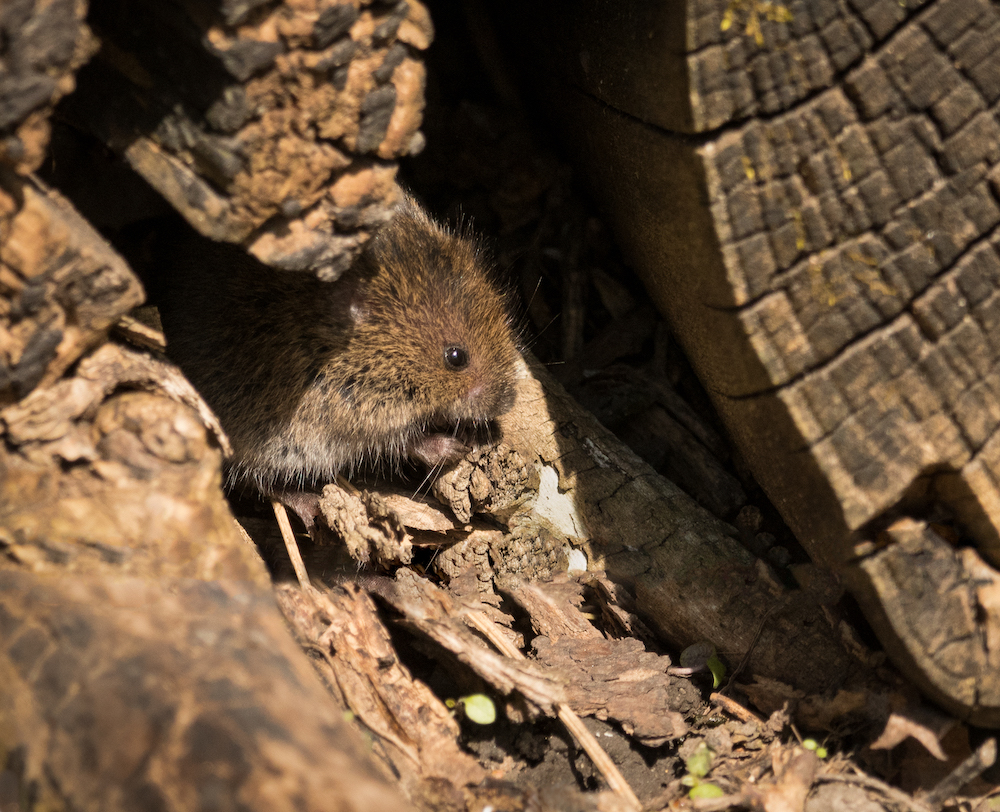
Photo by Shelia Newenham.



Photo by Shelia Newenham.
When talking about runways, many people envision planes landing at busy airports or maybe models strutting the latest fashions, but a biologist or gardener is just as likely to think: VOLES. Why? During the winter voles clip grass short to create surface runways (small trail systems) under a layer of snow to allow them to forage for food without being as exposed to the elements or predators. While voles create these runways all year, in natural areas they can be harder to see once the grass begins to grow tall in the spring, but they are quite obvious in lawns after the snow has melted. So who are these runway builders?

Voles belong to the Family Cricetidae along with other rodents such as rats, mice, muskrats, lemmings and hamsters. Illinois is home to three species of voles: the meadow vole (Microtus pennsylvanicus), the prairie vole (Microtus ochrogaster) and the woodland vole (Microtus pinetorum), also known as the pine vole.
While they are often confused with mice, voles are fairly easy to identify once you know what to look for, since they are stockier and have much shorter tails than mice. Larger than mice or shrews, voles are approximately 4.25 to 7 inches in length and weigh 25 to 50 grams, depending on the species. They have grizzled brown to reddish-brown fur, short legs, and small, furry ears. Their short tails are typically less than one-third of the length of their body.
So where are these diminutive rodents to be found? The meadow vole is common in the northern two-thirds of the state, while prairie and woodland voles are common throughout Illinois. Meadow voles inhabit grasslands in low-lying areas or near stream, lakes or swamps. Prairie voles prefer upland grasslands, fallow fields and fencerows, and they typically avoid wooded areas. As their name implies, woodland voles inhabit deciduous forests and grassy areas near woody areas.
Like many of Illinois’ other burrowing mammals, voles build shallow, underground burrow systems with many entrances. Meadow voles and prairie voles will also create surface runways through the grass, while woodland voles build surface runways just under the leaf litter. These runways are approximately 1 to 2 inches wide with nearby vegetation often clipped close to the ground. Meadow voles sometimes build nests of grass above ground, whereas the other two species construct their nests below ground.

Secure nesting sites are important because female voles can have several litters per year. Meadow and prairie voles have an average of three to five young per litter. Woodland voles average two to three young per litter. Amazingly, females can begin breeding at three weeks of age, and the young develop very quickly—typically on their own in about two or three weeks. Their proclivity for rapid reproduction is necessary for the species’ survival. Voles have a short lifespan, most living less than one year. This is because they are part of the base of the food web. All three species are a major food source for foxes, owls, hawks, snakes and many other predators of small mammals.
Voles are herbivores and feed heavily on grasses, sedges, alfalfa, goldenrods, clovers and plantains. They will also eat grains, seeds, berries, bulbs and occasionally insects or snails. When other foods are limited, voles will eat bark from the base of trees and shrubs. This behavior often occurs during the winter in Illinois.
Meadow voles and woodland voles are the species most likely to cause problems for farmers and gardeners in Illinois. Young orchard trees are particularly susceptible to vole damage during the winter when voles feed on bark and tree roots. Voles can kill trees if they girdle them or cause extensive root damage. Voles can also become a problem for homeowners if they severely damage garden or landscaping plants. Voles will voraciously feed on bulbs, tubers and corms, especially during the winter. Because voles often use the tunnel systems of moles, moles are sometimes blamed for landscaping damage caused by voles.

Since rabbits will also gnaw on bark, especially during the winter, close inspection is needed to see who has been chewing on your plants. To determine whether or not voles are causing the damage, look for irregular gnaw marks and note their width. Voles gnaw on bark from various angles and make marks approximately 1/8 inch wide, 3/8 inch long and 1/16 inch deep. Rabbit gnaw marks are wider and longer, and rabbits often clip off small branches at a 45-degree angle.
Habitat modification is the best way to control vole damage. In urban areas, keeping grass mowed short will reduce food resources and cover which will help reduce vole numbers in the area. Mulch should be kept at least 3 inches away from the base of trees. For tips on other damage control methods such as exclusion, repellents or trapping check out Wildlife Illinois. Unlike most other mammals in Illinois, voles are not protected by the Illinois Wildlife Code. They may be removed without a permit. In rural and suburban areas, maintaining quality wildlife habitat will provide homes for foxes, hawks and other species that will naturally control vole populations.
Laura Kammin is a Natural Resources Specialist with the National Great Rivers Research and Education Center. She formerly held positions at Illinois-Indiana Sea Grant, University of Illinois Extension, Prairie Rivers Network and the Illinois Natural History Survey. She received her master’s degree in wildlife ecology from the University of Illinois, Urbana-Champaign.
Submit a question for the author